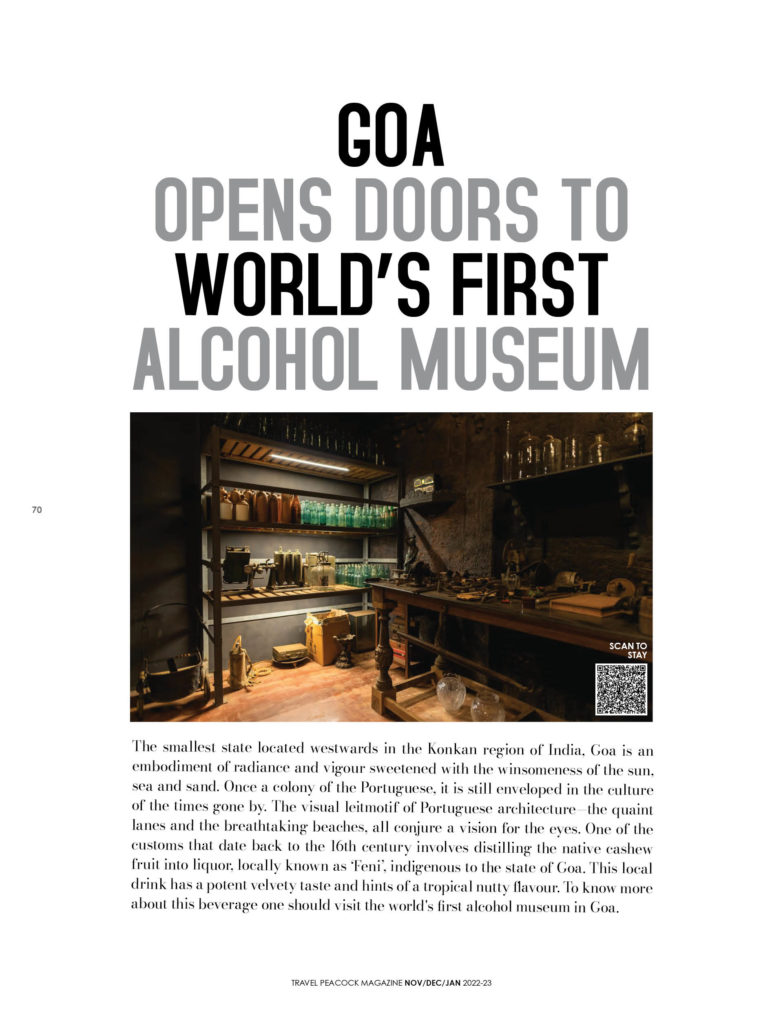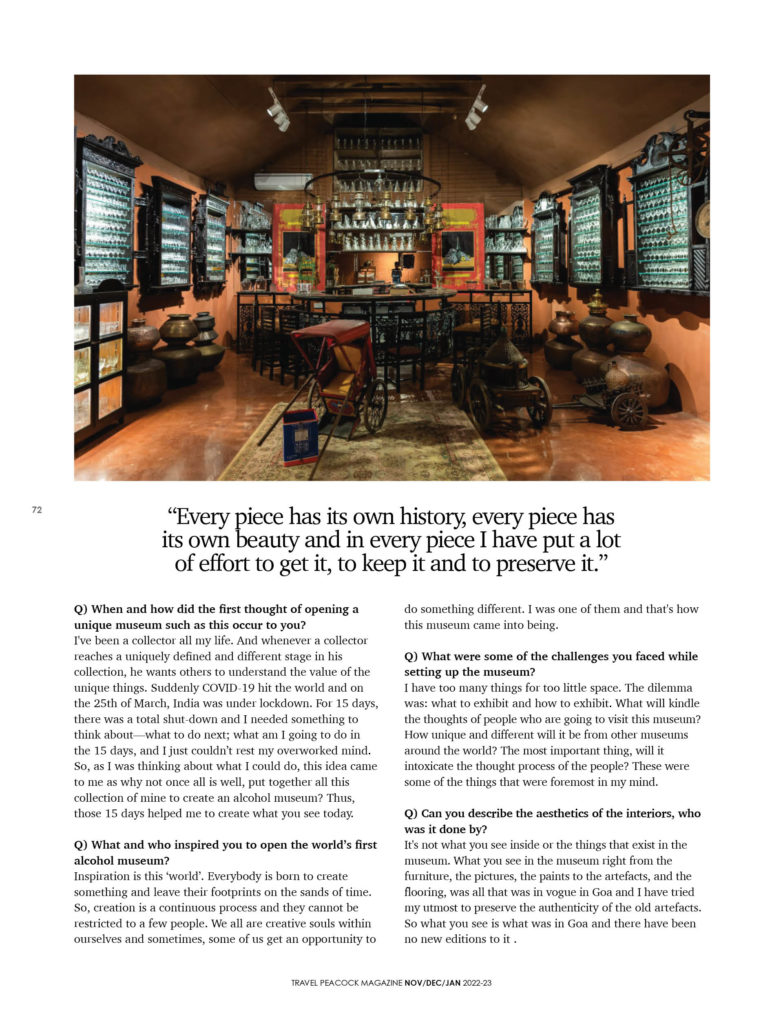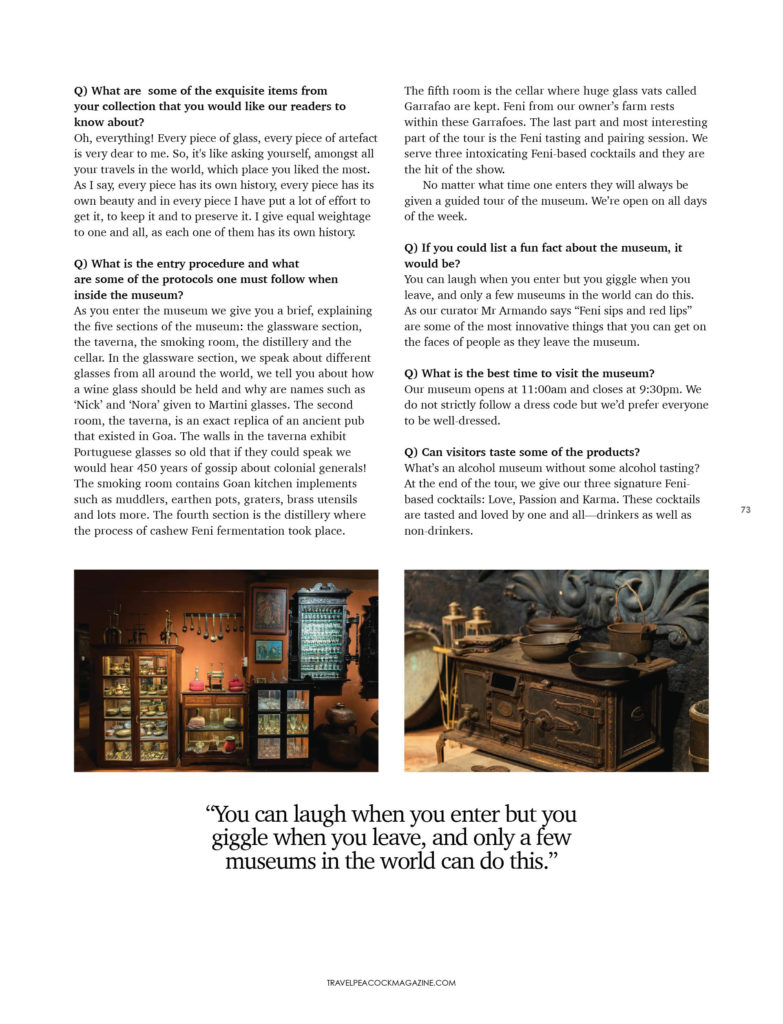
The smallest state located westwards in the Konkan region of India, Goa is an embodiment of radiance and vigour sweetened with the winsomeness of the sun, sea and sand. Once a colony of the Portuguese, it is still enveloped in the culture of the times gone by. The visual leitmotif of Portuguese architecture—the quaint lanes and the breathtaking beaches, all conjure a vision for the eyes. One of the customs that date back to the 16th century involves distilling the native cashew fruit into liquor, locally known as ‘Feni’, indigenous to the state of Goa. This local drink has a potent velvety taste and hints of a tropical nutty flavour. To know more about this beverage one should visit the world’s first alcohol museum in Goa.

Deemed the Louvre of Goa, the depository in Candolim opened doors to visitors in the month of August 2021. ‘All About Alcohol’ is a passion project of Nandan Kudchadkar, a businessman and an avid collector. His fetish with Feni gave birth to this one-off museum. Spread across 13,000 sq ft, the space is divided into five units featuring antique articles, a collection of glasses and a myriad of equipment. Kudchadkar has a wide collection of glasses from vintage to modern and you can view them all in one place i.e. ‘Kallis’—his museum of glasses. Kudchadkar believes alcohol is a social drink and should not be vandalised. It is an art and craft to relish. “Cheers are said so that all the five senses are involved while drinking; the eyes when you look at it, the smell when you pour it into the glass, the ears when you listen to cheers and the taste when you drink it,” he says.
A short yet detailed conversation with Kudchadkar and he patiently educates us about the ‘alcohol route,’ giving a quick reference of the famous ‘Spice Route.’ The colonial trade majorly influenced the alcohol manufacturing and consumption in Goa. The famous Goan local brew is a perfect example of East meets West. It was the air and water of Goa and the seed of Brazil that birthed the drink. Today, Feni is the only brew in the world that is naturally fermented. “Earlier this drink was only a prized possession of a Goan but now the world has understood its value and exquisite taste,” Kudchadkar concludes.
He shares more such interesting facts about alcohol and his museum. Read the excerpts:

Q) When and how did the first thought of opening a unique museum such as this occur to you?
I’ve been a collector all my life. And whenever a collector reaches a uniquely defined and different stage in his collection he wants others to understand the value of the unique things. And I’ve always been a great collector. Suddenly COVID hit the world and on the 25th of March, India was under lockdown. For 15 days, there was a total shut-down and I needed something to think about—what to do next; what am I going to do in the 15 days, and I just couldn’t rest my overworked mind. So, as I was thinking about what I could do, this idea came to me as why not once all is well, put together all this collection of mine to create an alcohol museum? Thus, those 15 days helped me to create what you see today.
Q) What and who inspired you to open the world’s first alcohol museum?
Inspiration is this ‘world’. Everybody is born to create something and leave his footprints on the sands of time. So, creation is a continuous process and they cannot be restricted to a few people. We all are creative souls within ourselves and sometimes, some of us get an opportunity to do something different. I was one of them and that’s how this museum came into being.
Q) Who has been a major support during this new journey you took on?
Destiny. Destiny has always been my greatest support. Time has also been my lucky charm. I am blessed by god. All my friends have always loved and supported me. And, of course, I would count the blessings of all the souls that exist in the state of Goa.
Q) What were some of the challenges you faced while setting up the museum?
I have too many things for too little space. The dilemma was: what to exhibit and how to exhibit. What will kindle the thoughts of people who are going to visit this museum? How unique and different will it be from other museums around the world? The most important thing, will it intoxicate the thought process of the people? These were some of the things that were foremost in my mind.
Q) Can you describe the aesthetics of the interiors, who was it done by?
It’s not what you see inside or the things that exist in the museum. What you see in the museum right from the furniture, the pictures, the paints to the artefacts, and the flooring, was all that was in vogue in Goa and I have tried my utmost to preserve the authenticity of the old artefacts. So what you see is what was in Goa and there have been no new editions to it .

Q) What are some of the exquisite items from your collection that you would like our readers to know about?
Oh, everything! Every piece of glass, every piece of artefact is very dear to me. So, it’s like asking yourself, amongst all your travels in the world, which place you liked the most. As I say, every piece has its own history, every piece has its own beauty and in every piece I have put a lot of effort to get it, to keep it and to preserve it. So, I would be biassed if I say one piece is lovely and the other is not. I give equal weightage to one and all. All the artefacts that are there in the museum are dear to me and each one of them has its own history.
Q) What is the entry procedure and what are some of the protocols one must follow when inside the museum?
As you enter the museum we give you a brief, explaining the five sections of the museum: the glassware section, the taverna, the smoking room, the distillery and the cellar. In the glassware section, we speak about different glasses from all around the world, we tell you about how a wine glass should be held and why are names such as ‘Nick’ and ‘Nora’ given to Martini glasses. The second room, the taverna, is an exact replica of an ancient pub that existed in Goa. The walls in the taverna exhibit Portuguese glasses so old that if they could speak we would hear 450 years of gossip about colonial generals! The smoking room contains Goan kitchen implements such as muddlers, earthen pots, graters, brass utensils and lots more. The fourth section is the distillery where the process of cashew Feni fermentation took place. The fifth room is the cellar where huge glass vats called Garrafao are kept. Feni from our owner’s farm rests within these Garrafoes. The last part and most interesting part of the tour is the Feni tasting and pairing session. We serve three intoxicating Feni-based cocktails and they are the hit of the show.
No matter what time one enters they will always be given a guided tour of the museum. We’re open on all days of the week.
Q) If you could list a fun fact about the museum, it would be?
You can laugh when you enter but you giggle when you leave, and only a few museums in the world can do this. As our curator Mr Armando says “Feni sips and red lips” are some of the most innovative things that you can get on the faces of people as they leave the museum. It’s all about red lips and Feni sips.
Q) What is the best time to visit the museum?
Our museum opens at 11:00am and closes at 9:30pm. We do not strictly follow a dress code but we’d prefer everyone to be well-dressed.
Q) Is photography allowed inside the museum?
Yes, we do allow photography and small video snippets could be taken too.
Q) Can visitors taste some of the products?
What’s an alcohol museum without some alcohol tasting? At the end of the tour, we give our three signature Feni-based cocktails: Love, Passion and Karma. These cocktails are tasted and loved by one and all—drinkers as well as non-drinkers.

 Add to favorites
Add to favorites
